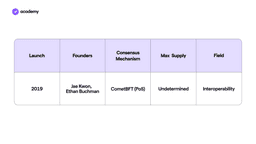
Cosmos is an ecosystem for the development of highly scalable and interoperable blockchains. Find out what it is in detail, how its crypto works and future developments.
What is Cosmos?
Cosmos is a Layer-0 ecosystem and blockchain, also called Interchain.
Similar to Polkadot, its aim is to enable the development of Layer-1 blockchains in a fully interoperable and flexible environment.
This ecosystem is made up of several ‘Hubs’, i.e. blockchains corresponding to individual projects, which may in turn have several blockchains for specific applications, called ‘Zones‘.
One of the hubs within this ecosystem is the Cosmos Hub, powered by the ATOM cryptocurrency.
Other examples of blockchains built on Cosmos are Cronos, Kava, Osmosis, ThorChain and soon the dYdX blockchain.
The protocol was born at the hands of two software engineers, Jae Kwon and Ethan Buchman, and is being pushed forward thanks to the Interchain Foundation and the company Ignite (formerly Tendermint). After a successful ICO in 2017, the network was sent online publicly in 2019.
Let us now take a closer look at what Cosmos is and how its structure works.
How does the Cosmos ecosystem work?
This layer-0 blockchain was created to facilitate complete interoperability between the blockchains that rely on it, while at the same time providing excellent scalability and flexibility.
This is possible thanks to a number of open-source tools such as Cosmos SDK for development, IBC for communication and CometBFT for consensus. Let’s see what each one is briefly.
Cosmos SDK
An SDK generally is a set of development tools used to programme applications on specific platforms. The acronym in fact stands for Software Development Kit.
Cosmos is an open-source SDK that allows blockchains of different types to be developed quickly and easily. The framework is so flexible that it gives the possibility to create both classic Proof-of-Stake and Proof-of-Authority public blockchains. Moreover, the SDK is composed of pre-built modules, which can be combined together to create blockchains for specific applications. Being open-source, then, new modules can be added by any programmer.
In this way, programmers do not have to worry about developing consensus, interoperability, or networking, but can focus directly on the application to which the blockchain is dedicated. By the way, let us now find out what it is in Cosmos that facilitates the connection between hubs.
Inter-Blockchain Communication (IBC)
The IBC is a standard for bridges, i.e. for interoperability. It is how hubs communicate with each other. Every blockchain built on Cosmos natively includes the IBC, and although they are all independent chains with different consensus mechanisms or assets, thanks to this standard they can exchange information, assets or interact. According to Messari (August 2023), this is the most flexible interoperability protocol to date. Indeed, thanks to the Interchain Account system, it is possible from one blockchain to operate with an application based on another blockchain.
The IBC is also slowly spreading outside of Cosmos, thanks to several teams of developers who have already connected Polkadot and Kusama and who are working on creating a connection with Ethereum and Avalanche as well.
CometBFT
The consensus mechanism on Cosmos is programmable, but the platform provides a basic Tendermint-based protocol, CometBFT.
Tendermint is an algorithm invented by co-founder Jae Kwon himself, and is highly scalable. The system is Byzantine Fault Tolerant, which means that it continues to work even in the case of malicious actors or inactive nodes. In fact, it requires the vote of at least 2/3 of the network to reach consensus.
Consensus with Tendermint is also based on Bonded-Proof-of-Stake (BPoS), where validators are selected to produce and sign blocks based on staked or delegated tokens.
CometBFT thus allows instant execution of transactions at low cost, and saves the creators of new blockchains from having to develop an entire consensus system.
But what do you stake on Cosmos? Let’s move straight on to the leading currency in the ecosystem.
ATOM tokenomics
ATOM is the crypto of the Cosmos Hub, and follows the Interchain ICS-20 standard. It can therefore be transferred between all blockchains in the ecosystem, via the IBC protocol.
The functions and use cases of the token are as follows:
- Payment of transaction fees
- It is used by validators for staking
- New tokens are the rewards for staking
- It can be delegated to a validator to receive part of its rewards
- It is used to vote in on-chain governance processes
68% of the tokens initially created were distributed with an ICO, the rest went to the contributors of the project. All tokens created are currently in circulation and there is no maximum number of units that can be created, so there is no limit to inflation in this respect.
If therefore the rewards of staking constitute an inflationary pressure for ATOM, the token also presents two deflationary measures: burning and slashing.
Burning takes place in the context of governance processes. In fact, at least 250 ATOMs must be deposited to submit a proposal. If this proposal is vetoed, the tokens are burned, i.e. removed from the available supply.
Slashing, on the other hand, is the elimination of rewards for a validator who has behaved in a way that is detrimental to the network. This occurs, for instance, in cases of double spending or if the validator remains offline for long periods.
Cosmos 2.0
In September 2022, a new version of the Cosmos Hub was proposed with a whitepaper drafted by members of the community. This proposal was rejected by the rest of the community, but individual initiatives included in the paper were brought back for discussion, and some are in development.
These include an increase in the size of the treasury and liquid staking, which would benefit the token. In fact, ATOM holders will be able to use staked tokens throughout the Cosmos ecosystem. This incentivises the staking of ATOM and, in the long run, will change the issuance of ATOMs from an inflationary to a deflationary model.
Now that you know what Cosmos is, why not take a look at its market? Check it out on Young Platform!



